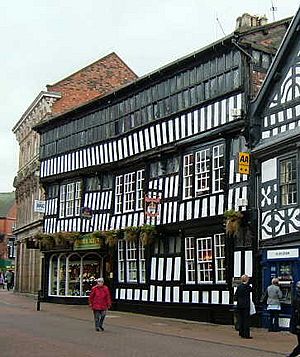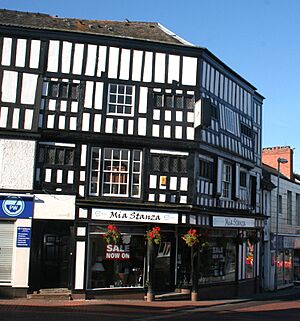Nantwich Castle facts for kids
Nantwich Castle was a Norman castle located in Nantwich, Cheshire, England. It was built a very long time ago, before the year 1180. Its main job was to protect a shallow crossing point (a ford) over the River Weaver. We first find records of the castle in 1288. The last time it was mentioned was in 1462, and by 1485, it was already a ruin. Today, you can't see any parts of the castle above ground. However, in 1978, archaeologists dug near the Crown Inn. They found signs of raised ground and two ditches. These might have been part of the castle's outer defensive area, called a bailey.
Contents
Castle History
The castle was built sometime before 1180. We don't know exactly who built it or when. Some people think it was built by William Malbank. He was the first baron, or powerful lord, of Nantwich.
However, a local historian named Eric Garton found a document. It called the castle "the Castle of Piers Malbanke." We don't know much about Piers Malbanke otherwise. He might have been a brother of William Malbank or one of his family members.
Archaeologists believe the castle stood on slightly raised land. This land was between the River Weaver and what are now High Street and Mill Street. It was probably close to the Crown Inn. This spot was one of the highest points in Nantwich. It gave the castle a strong position to watch over the ford of the Weaver. This ford was just south of the current bridge.
Nantwich Castle was a baron's castle, but it wasn't one of the biggest castles in Cheshire. An old description from 1818 by John Weld Platt said it was "square, with towers at each corner." He also said its outer walls had a wide moat, which you could only cross by a drawbridge. But a later historian, James Hall, thought this description was made up. So, it's not a reliable historical fact.
How the Castle Changed Hands
Around 1160–70, the third baron died without any sons. His lands and special rights were then split among his three daughters. A record from May 15, 1288, says the castle went to his oldest daughter, Philippa. This is the first official document that proves the castle existed.
Philippa Malbank married Thomas, Lord Basset. Their daughter, also named Philippa, married Henry de Beaumont, 5th Earl of Warwick. The castle later went back to the Earl of Chester in the 13th century. This happened when Philippa, Countess of Warwick, died without children.
On June 22, 1278, King Edward I gave the castle to Randle de Merton. Then, on August 25 of the same year, it passed to Sir Randle Praers. His grandson, Thomas Praers, later sold most of his lands, including the castle. He sold them to his neighbor, John Gryffyn of Bartherton, for a very small rent of one rose each year.
This sale seemed to cause some trouble. On May 16, 1344, Edward, the Black Prince, who was the Earl of Chester, wrote about it. He had heard that Thomas de Praers was "a natural born fool" and had sold his lands foolishly. So, the Black Prince had Thomas examined by his council. They found that Thomas was actually "a man of sound memory" and able to manage his lands.
After Thomas Praers died, the castle passed to his daughter and heir, Elizabeth. She married Sir Robert Fouleshurst. The castle then stayed in the Fouleshurst family for some time.
The Castle's End
The last time Nantwich Castle was mentioned in records was in 1462. By 1485, it had become a ruin. People believe that stones from the castle were used to build parts of St Mary's Church. Some say they were used for the Kingsley Chapel. However, that chapel was likely built around 1405, which is earlier than when the castle was fully ruined.
By 1550, the area where the castle stood was called Lamburcote or Lambercote. It was used as grazing land for animals. In the early 1800s, when George Ormerod wrote his History, there was no sign of the castle left above ground. Much of the area was flattened in the 1950s to create a car park.
What's Left Today?
In 1978, archaeologists dug behind the Crown Inn. They found signs of raised ground, which might have been a platform or mound. They also found two ditches lined up. One was older and steep-sided, possibly from before the medieval period. The other was a larger medieval ditch.
This later ditch might have been the outer bailey of the castle. A bailey is an outer courtyard or defensive area. This ditch was smaller than those of most castles. This might be because the nearby river already provided a natural barrier. Or, it could have been used as a moat, a water-filled ditch for defense. This ditch filled up with dirt in the 13th century. This suggests the castle might have stopped being used for defense around that time.
The older ditch might have been an earlier part of the castle's defenses. Or, it could have been part of an even older structure. For example, the Domesday survey mentions a ditch around the town's salt houses.
Earlier digs in 1974 and 1976 also found a large ditch. This was behind 28 High Street. Experts believe it was a continuation of one of the ditches found in 1978. In 1979, during sewer work, evidence of a drawbridge was also found.
So far, no evidence of stone buildings from the castle has been found. This could mean that all the stone was reused for other buildings. Or, the castle buildings might have been in a spot that hasn't been dug up yet, perhaps under the modern High Street. It's also possible that the castle was never a large stone structure, but rather a smaller building made of timber (wood).
Castle's Influence on Town Layout
The castle has affected how the town's streets are laid out. The modern High Street is thought to follow the castle's outer wall. From Hospital Street, one of the town's oldest streets, High Street gently curves towards the River Weaver. There's a sharper bend where Regent House now stands. All the main streets on the east side of the river spread out from High Street. The name "Castle Street" is believed to come from the castle. However, this name was first recorded in 1489, when the castle was already in ruins.



